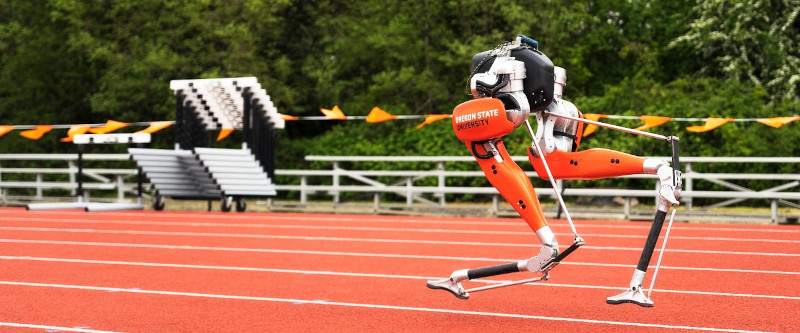
Bipedal robot runs world-record 100-meter dash
By DE Staff
GeneralOSU’s Cassie robot uses machine learning to control running gait on outdoor terrain.

Cassie the robot sets 100-meter record.
(Photo credit: Kegan Sims/Oregon State University)
An untethered robot, invented at the Oregon State University College of Engineering and produced by OSU spinout company, Agility Robotics, has established a Guinness World Record for the fastest 100 meters by a bipedal robot. Named Cassie by its inventors, the robot set a time of 24.73 seconds, starting and finishing the sprint from a standing position without falling.
Unlike a human sprinter, Cassie has bird type legs with knees that bend backwards. The robot also doesn’t have a vision system and operates without cameras or external sensors. To learn how to sprint, the OSU researchers say the robot’s programming was trained in a week-long simulation that compressed a year’s worth of training experiences by computing numerous calculations simultaneously.
The 100-meter dash is Cassie’s second record setting performance. In 2021, the robot completed a 5km run in just over 53 minutes on a single battery charge, making it the first untethered bipedal robot to use machine learning to control a running gait on outdoor terrain, the researchers say.
Cassie was developed under the direction of OSU robotics professor, Jonathan Hurst, with a 16-month, $1 million grant from DARPA. Introduction in 2017, the robot became Agility Robotics first commercial robot and has used by top university’s and robotics labs in the U.S. as a platform for exploring machine learning.
“This may be the first bipedal robot to learn to run, but it won’t be the last,” said Hurst, who is also Agility Robotics CTO. “I believe control approaches like this are going to be a huge part of the future of robotics. The exciting part of this race is the potential. Using learned policies for robot control is a very new field, and this 100-meter dash is showing better performance than other control methods. I think progress is going to accelerate from here.”
https://mime.oregonstate.edu
